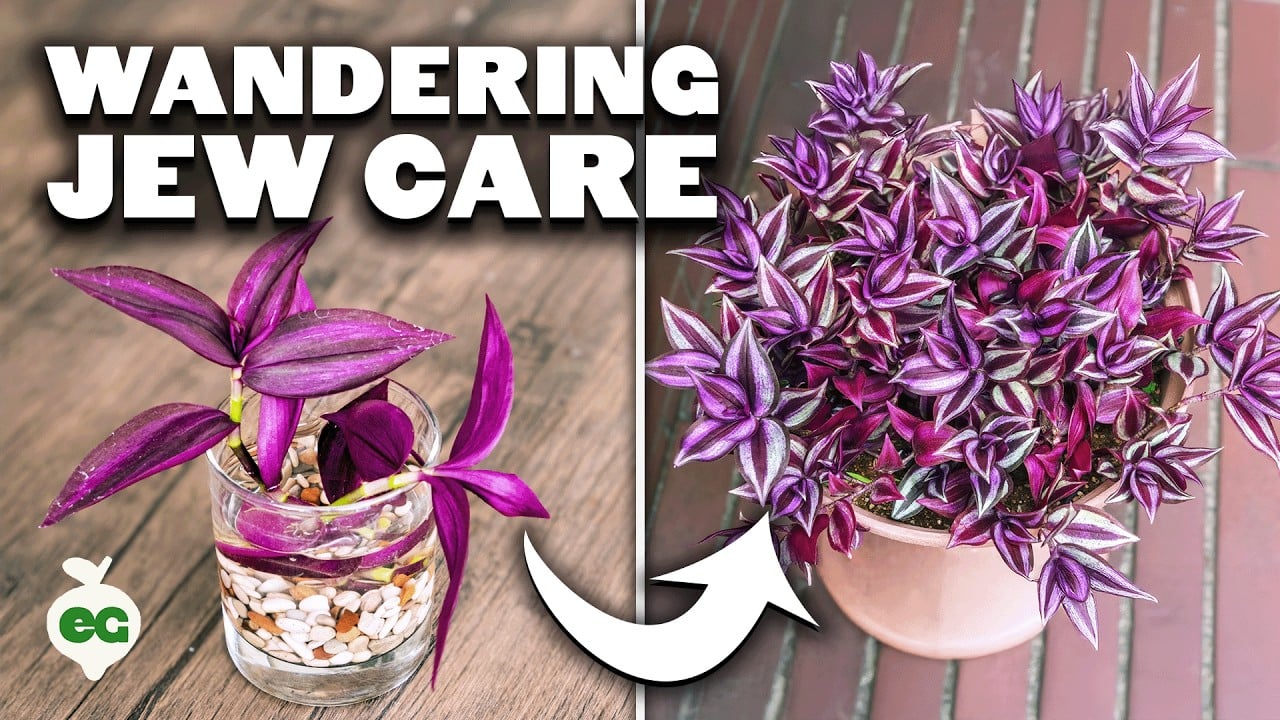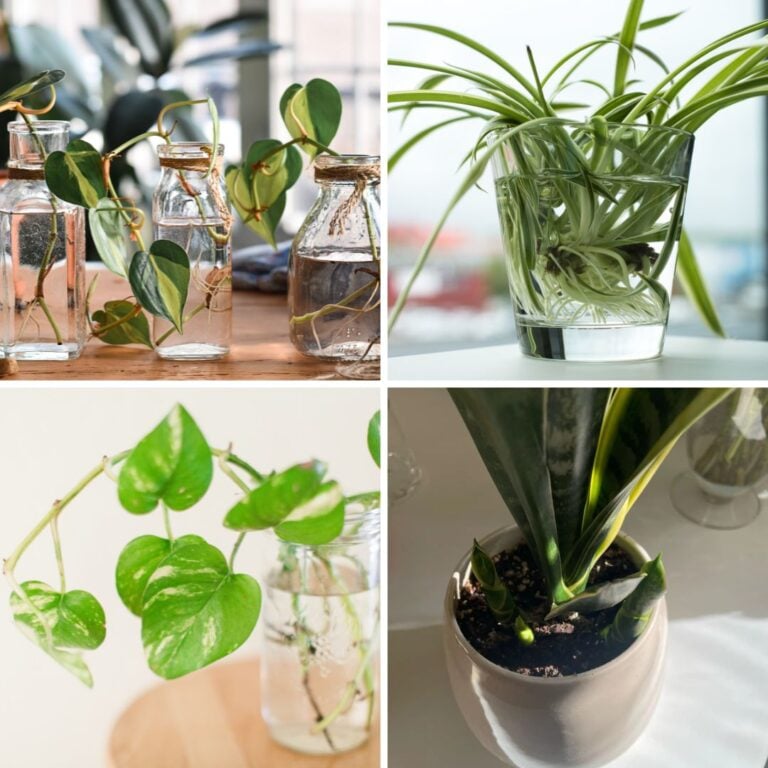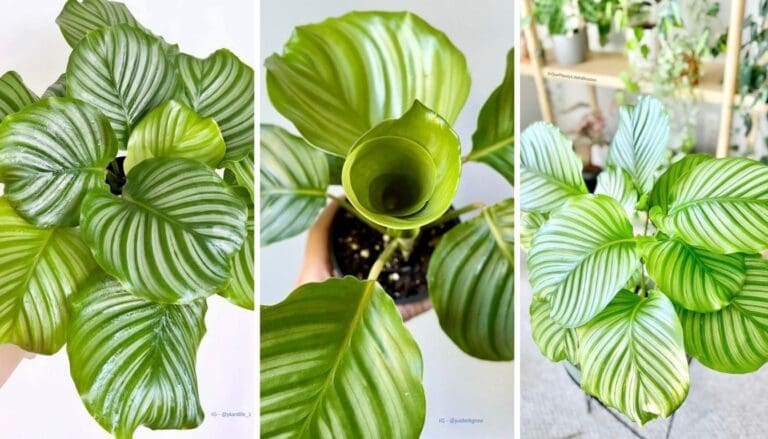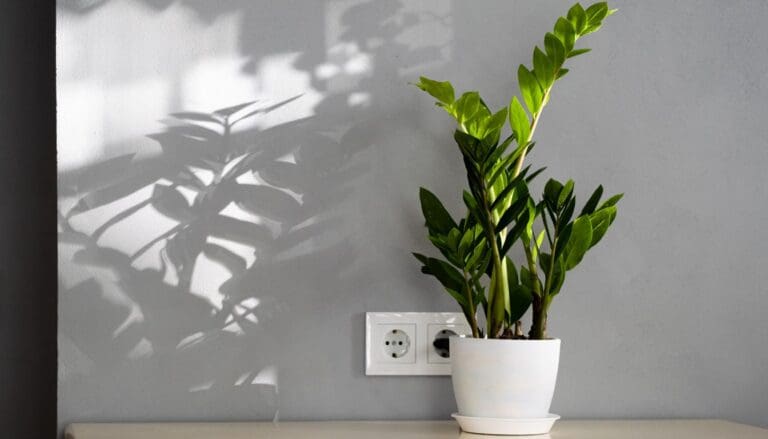Wandering Jew Plant Care: Easy Tips for Thriving Houseplants
Taking care of a Wandering Jew plant is simpler than you might think! These beautiful, trailing plants brighten up any room with their colorful leaves.
To keep your Wandering Jew plant thriving, make sure it gets bright, indirect sunlight and regular watering.
Is your plant in a spot where it can soak up morning sun but avoid the harsh afternoon rays? Perfect!
One reason I love Wandering Jew plants is how easy they are to propagate. Just snip off a few healthy cuttings and pop them into moist soil or water—a great way to share plants with friends or expand your indoor jungle! 🌿
Do you have a favorite spot in your home where you think a new plant baby would look cute?
Have you ever noticed your Wandering Jew plant looking a little cramped?
Repotting is crucial when your plant outgrows its space.
Choose a pot that’s just a bit bigger and refresh the soil. It’s like giving your plant a roomier home!
Got any other plant care tips or quirky plant stories? Drop them in the comments—I can’t wait to hear from you! ✨

Please note: Simplify Plants is reader-supported. As an Amazon Associate, I earn from qualifying purchases made by our readers with no extra cost added to you all! Some links in the post are affiliate links and I get a commission from purchases made through links in the post.
Basic Plant Overview
Let’s talk about the Wandering Jew plant. This plant is known for its vibrant, colorful leaves and easy care. It’s perfect for adding a splash of green (and sometimes purple or pink) to any room.
The Wandering Jew plant belongs to the Tradescantia genus and has a few different types. Some common varieties include the inch plant, purple queen, and striped wandering Jew. Each variety has its unique flair, but they all share the same easy-going nature.
To keep this plant happy, you’ll need a pot with proper drainage. Nobody likes soggy roots, right? Make sure the potting mix is well-drained and rich.
Want your plant to thrive? Place it in bright, indirect sunlight. Too much direct sun can scorch those lovely leaves, while too little light can make it leggy and dull.
Temperature-wise, keep it in a comfy spot with temperatures around 60-75°F (16-24°C). Cooler temps in winter are okay, around 54-59°F (12-15°C).
Fertilizing time! During the growing seasons (spring and summer), give it a boost with some fertilizer once a month.
Here’s a fun fact: You can easily propagate the Wandering Jew! Just take a cutting, remove the bottom leaves, and stick it in the soil. Watch it grow! 🌿
Do you have a Wandering Jew plant? How is it doing? Share your experiences in the comments! 💬✨
Table: Wandering Jew Plant Quick Facts
| Feature | Details |
|---|---|
| Light | Bright, indirect sunlight |
| Temperature | 60-75°F (16-24°C); cooler in winter |
| Watering | Keep soil moist, not soggy |
| Soil | Well-drained, rich potting mix |
| Fertilizing | Once a month during spring and summer |
Let’s keep our green friends thriving together! 🌟
Optimal Growing Conditions

I’ve learned that the key to a thriving Wandering Jew plant is all about the right balance of light, water, temperature, and soil. Let’s dive into how to create the best environment for these beautiful plants!
Light Requirements
Wandering Jew plants love bright, indirect sunlight. 🌞
Think about a spot where they can catch lots of natural light but aren’t scorched by direct sun rays. Too much direct sunlight can cause the leaves to lose their vibrant colors, while too little light will result in leggy growth and dull colors.
Placing them near a north or east-facing window works wonders. If you’re indoors, consider using a sheer curtain to diffuse the light.
Got any windows that fit this description?
Watering Schedule
Keeping these plants happy involves regular watering, but the soil shouldn’t be waterlogged.
I usually check the top inch of soil—if it’s dry, it’s time to water.
On average, I water my Wandering Jew once a week during the growing seasons like spring and summer.
In the winter, the plant needs far less water, so cutting back to once every two weeks often does the trick.
Remember, too much water can lead to root rot. Ever been guilty of overwatering? 🌱
Temperature and Humidity
Wandering Jew plants prefer a cozy atmosphere. Temperatures between 60-75°F (16-24°C) are ideal. If it gets too cold, below 50°F (10°C), they can suffer.
Keeping them away from drafty windows or air conditioning vents is essential.
Humidity-wise, these plants like it a bit on the higher side. If your home is dry, you can increase humidity by misting the plant or placing it near a humidifier.
Got a misting bottle handy? 💧
Soil Considerations
Good soil makes a big difference. Wandering Jew plants thrive in well-draining, rich potting mix. A mix designed for houseplants, often rich with organic material, is perfect.
Ensure your pot has drainage holes to prevent water from sitting at the bottom.
When repotting, I like to add a little fresh potting soil around the sides to support root growth. Ever tried mixing your own soil blend?
Planting and Repotting

When you plant or repot your Wandering Jew plant, it’s essential to choose the right pot and follow the correct repotting process to ensure the plant thrives. Let’s dive into the steps!
Choosing a Pot
First, let’s talk about the pot. You want a pot with good drainage. Wandering Jew plants don’t like soggy roots, so make sure there are holes at the bottom.
For young plants, start with a 6-inch pot, and as the plant grows, move up to a gallon-sized pot if needed. Your soil needs to be rich and well-draining.
Terracotta pots are an excellent choice because they help the soil dry out between watering.
Remember, if the pot is too large, it may hold too much moisture, leading to root rot.
Repotting Steps
Is your Wandering Jew looking cramped in its pot? It might be time to repot. Here’s what you need to do:
- Prepare the new pot: Choose a pot 1-2 inches wider than the current one. Add a layer of fresh, well-draining potting soil at the bottom.
- Remove the plant: Gently take the plant out of its current pot. If it’s stuck, lightly tap the pot or use a knife to loosen the soil around the edges.
- Place in new pot: Position the plant in the center of the new pot. Add soil around the sides, pressing it down gently.
- Water thoroughly: Once the plant is settled in its new home, water it until the soil is moist but not soggy.
Tip: Avoid repotting during winter, as the plant is typically dormant. Spring or summer is ideal.
Propagation Techniques

Growing new Wandering Jew plants is quite easy and fun. There are two main ways to do it: Stem Cuttings and Leaf Cuttings. Each method has its own steps and special tips to ensure success.
Stem Cuttings
Taking stem cuttings is the most popular way to propagate a Wandering Jew plant.
First, choose a healthy stem that is about 4-6 inches long. Make a clean cut right below a node using sterilized scissors.
Remove the lower leaves, leaving a couple at the top.
You can place the cutting in a jar of water, ensuring the lower leaf nodes are submerged.
Place the jar in a spot with bright, indirect light. Change the water every few days to keep it fresh. 🌞
After about 1-2 weeks, you should see roots developing!
Once the roots are a few inches long, you can carefully transfer the stem to a pot with pre-moistened potting soil.
Gently press the soil around the new plant and water lightly. Keep the soil moist but not too wet.
Leaf Cuttings
While not as common, you can also propagate a Wandering Jew from leaf cuttings.
Choose a healthy leaf from the plant. Gently cut the leaf with a bit of stem attached. This stem part is important because it’s where the roots will form.
Prepare a small pot with moist potting soil. Make a small hole in the soil and insert the stem part of the leaf cutting. Be sure the cut part is in contact with the soil.
Water lightly to keep the soil moist.
Cover the pot with a plastic bag to create a humid environment, which helps in root formation.
Place the pot in a bright area with indirect light. 🌱 Check regularly and water if the soil starts to dry out.
In a few weeks, you should notice new growth!
Once the plant is established, you can remove the plastic bag and care for it like any other Wandering Jew plant.
Routine Maintenance

Taking care of wandering jew plants can be super rewarding. With the right routine, your plant will flourish and look gorgeous all year long. Let’s look at key tasks like pruning, fertilizing, and pest management.
Pruning
Pruning keeps wandering jew plants in shape and encourages new growth. I trim my plant regularly to prevent it from becoming leggy and to promote a bushier look.
It’s best to prune in spring and summer, during the plant’s growing season.
I use clean, sharp scissors to cut back the long stems. I trim just above a leaf node, which is where the leaves grow from the stem.
Cutting above a node helps the plant to stay healthy and encourages it to grow in a full, lush pattern.
Regular pruning is key to maintaining its shape and promoting vibrant growth. Plus, the cuttings can be used to propagate new plants.
Fertilizing
Fertilizing isn’t always necessary, but it can give your wandering jew plant a nice growth boost.
I like to use a balanced liquid fertilizer, like a 20-20-20 mix.
I usually fertilize once a month during the spring and summer when the plant is actively growing.
I dilute the fertilizer to half strength, mix it properly, and then water my plant with this solution.
Be careful not to over-fertilize, as this can harm the plant. Once every two months is plenty if you’re not seeing any growth issues.
Skipping fertilizing during the fall and winter is a good idea, as the plant doesn’t grow much during these seasons.
Pest Management
Pests can occasionally be a problem with these plants. Common ones include aphids, spider mites, and mealybugs.
I inspect my plant regularly to catch infestations early.
If I see any pests, I remove them with a strong stream of water or by wiping the leaves with a damp cloth.
For a more persistent problem, I sometimes use insecticidal soap or neem oil. These are effective and less harsh than chemical pesticides.
Keeping the plant’s environment clean and maintaining good air circulation helps prevent pests.
Have you ever battled pests on plants before? It can be so frustrating! 😅 If you have any tips, share them in the comments below!
Remember, consistent care leads to a happy, healthy plant! 🌿💚 What routine care tips work best for you? Let me know in the comments!
Troubleshooting Common Issues
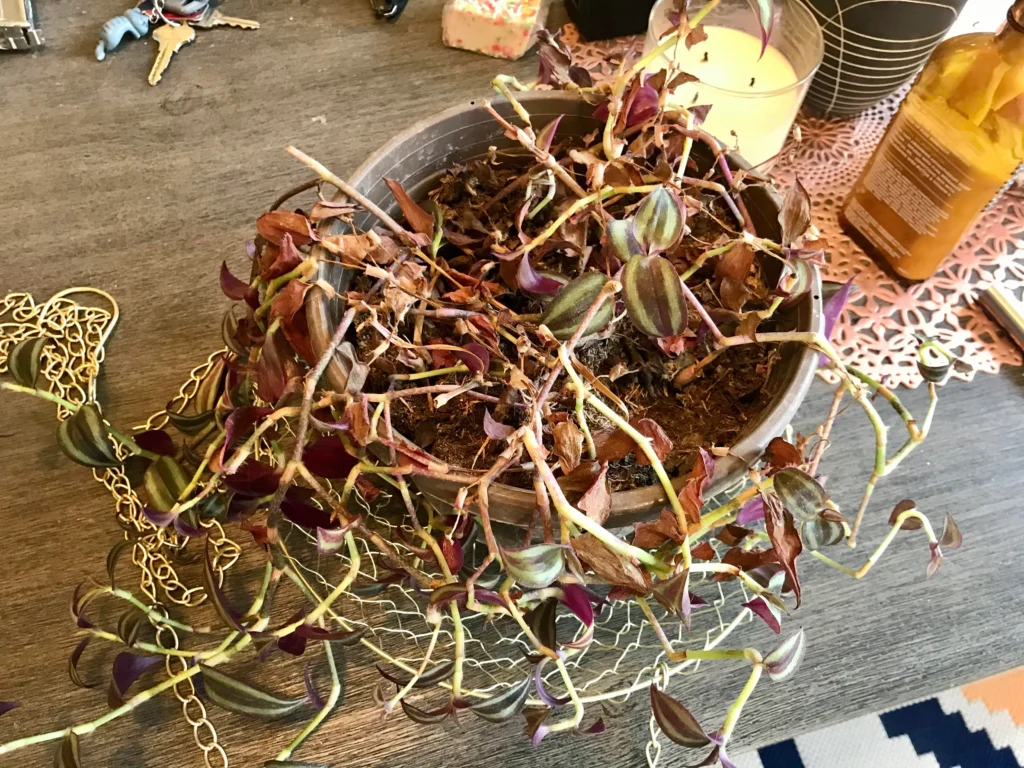
Taking care of a Wandering Jew plant can be fun, but sometimes you might run into problems. Don’t worry! Here are some common issues you might face and how to fix them. 🌿
Yellow Leaves
Yellow leaves can mean a few different things. Often, overwatering is the main culprit.
Make sure you let the top inch of soil dry out before you water again.
Stick your finger in the soil to check. Too much water can drown your plant’s roots.
Sometimes, yellow leaves also mean the plant isn’t getting enough nutrients.
Think about feeding your Wandering Jew a balanced liquid fertilizer every month.
If the light is too dim, leaves might yellow too, so give your plant bright, indirect light.
Has anyone else faced yellow leaves? Share what worked for you! 🌻
Leggy Growth
Is your Wandering Jew plant stretching out and looking thin? It might be craving more light.
Leggy growth happens when the plant reaches for light that’s too far away.
Try moving it closer to a window where it can get bright, indirect sunshine.
You can also prune the plant to make it fuller.
Cut the stems back, and it will grow more leaves and branches. Think of it as a haircut for your plant! ✂️ Wondering Jew plants grow fast and love a good trim.
If you’ve seen leggy growth in your plant, leave a comment. What kind of light helped your plant thrive? ☀️
Root Rot
Root rot is often due to poor drainage or overwatering. It’s a big problem because it can kill the plant.
Ensure your pot has a drainage hole and use well-draining soil.
If you notice mushy, smelly roots, your plant might have root rot.
To save it, take the plant out of the pot and cut away the rotten roots with clean scissors.
Replant in fresh soil and water less frequently. Let’s keep our plants happy and healthy! 🌱
Have you had to deal with root rot? How did you manage it? Feel free to share your experiences and tips in the comments below! 😊
Decorative Tips
Sprucing up your space with a Wandering Jew plant? I’ve got some super fun ideas to make it look even more awesome in your home! Whether you want to showcase its vibrant leaves or pair it with other plants, these tips are for you.
Display Ideas
I love placing Wandering Jew plants in hanging baskets. The trailing vines cascade beautifully, making any corner look lively. They’re perfect for living rooms or even kitchens. 🪴
Shelves and bookcases are another great spot. Imagine those colorful leaves peeking out between your books! It makes the room feel so inviting.
You can also use ceramic or colorful pots to match your home decor. Make sure the pots have drainage holes so your plant stays healthy.
For a more modern look, you can opt for geometric planters. They add a stylish touch while keeping the focus on the plant.
Finally, placing the plant near a window ensures it gets plenty of bright, indirect sunlight, which highlights its beautiful colors.
Companion Plants
Wandering Jew plants look amazing with other houseplants. I often pair them with spider plants. 🕸️ The contrasting colors and textures make a striking display.
Another great companion is the pothos plant. Both are easy to care for and grow well together, creating a lush, green oasis. 🌿
Succulents also make a fun, quirky combo. They add interesting shapes and sizes next to the trailing vines.
Imagine a cute little cactus surrounded by those vibrant Wandering Jew leaves! It’s an eye-catching mix.
Do you have favorite plant combos? Drop your ideas in the comments below! Let’s swap some plant decor tips! 🌱
FAQS
How much light does a Wandering Jew plant need?
Wandering Jew plants love bright, indirect light. Too much direct sun can burn the leaves, while too little light can make the colors fade 😓.
How often should I water my Wandering Jew?
I water mine when the top inch of soil feels dry. Be careful not to overwater; it can cause the stems to get mushy.
Why are the leaves on my plant turning brown?
Brown leaves usually mean the plant is getting too much water or not enough light. Adjust your care routine and see if it improves 😊.
How do I keep the soil from becoming hydrophobic?
If water runs around the edges and doesn’t soak in, try soaking the pot in water for a few minutes to rehydrate the soil. Sometimes, soil can become too dry.
Can I propagate my Wandering Jew?
Yes! You can easily propagate it. Just cut a healthy stem and put it in water until it grows roots. Before you know it, you’ll have more plants to share 🌱.
What should I do if my plant feels heavy or light?
A heavy pot means it has enough water, while a light pot means it needs a drink. Use this simple trick to keep your plant happy.
How do I keep my plant looking full and bushy?
I trim the tips every now and then to encourage new growth. This helps the plant stay bushy and vibrant.
Conclusion
Taking care of a Wandering Jew plant is a rewarding experience. With just a little attention, you can keep it vibrant and thriving! 🌱
Remember to provide bright, indirect sunlight and keep the soil well-drained.
Your plant will love you for this!
Have you ever tried propagating from stem cuttings? It’s super easy and fun! ✂️
I always make sure to water regularly but not too much. Overwatering can lead to root rot. Do you have any tips for avoiding this?
Feel free to let me know in the comments! 🗨️
Fertilizing once a month during the growing season helps keep my plant lush.
Transferring it to a cooler spot in winter has worked wonders as well.
Give it a go and share your experiences! Have any plant hacks? Drop them below! 🌿
Note: Some images in the articles are sourced from Reddit and Other Platforms For Reference Purpose.

